1) Which of the following statements is most consistent with data obtained from the fossil record?
A. Unused body parts decrease in size.
B. Geologic changes occur quickly on Earth.
C. Organisms have an innate drive to increase in complexity.
D. Older strata carry fossils that differ greatly from living organisms.
D
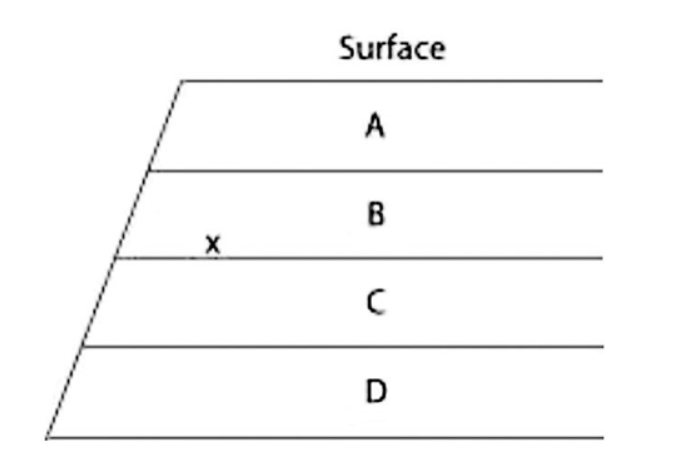
2) The figure shows an outcrop of sedimentary rock whose strata are labeled A-D. If x indicates the location of fossils of two closely related species, then fossils of their most-recent common ancestor are most likely to occur in which stratum?
A
B
C
Ddd
C
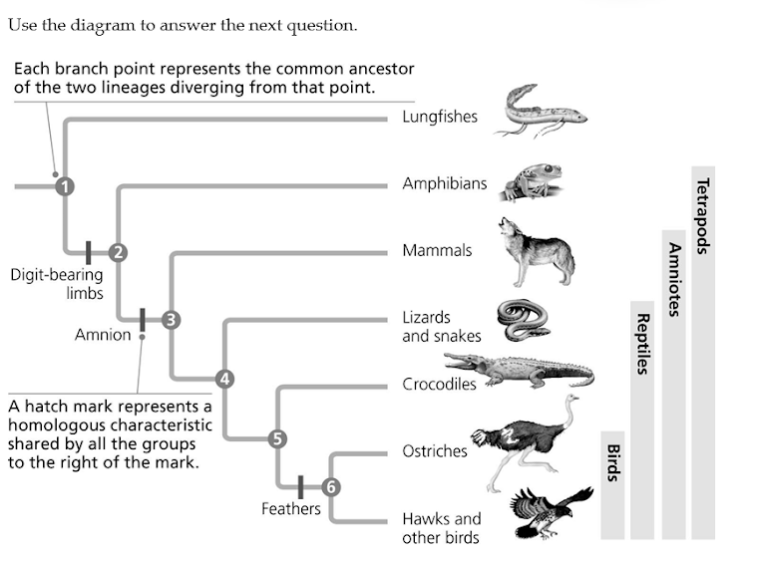
3) Which of the following conclusions is consistent with the information in the evolutionary tree?
A. The amnion occurs in all organisms that have digit-bearing limbs.
B. Feathers contribute to temperature regulation in birds.
C. The amnion occurs in mammals, birds, and lizards.
D. The amnion is a membrane that surrounds developing embryos.
C
4) The cow Bos primigenius (which is farmed for meat and milk) has a smaller brain and larger eyes than closely related species of wild ungulates. Which of the following statements best describes the process that led to differences between domesticated/farmed cows and their wild relatives?
A. Natural selection resulted in changes in the wild species because humans preyed upon them.
B. Artificial selection resulted in changes in the lineage leading to domesticated cows because humans wanted animals that would see predators and escape from them.
C. Natural selection resulted in changes in the lineage leading to domesticated cows because humans provided food for their cows.
D. Artificial selection resulted in changes in the lineage leading to domesticated cows because humans wanted animals with high milk output and high muscle content.
D
5) Claytonia virginica is a plant with flowers that vary from white, to pale pink, to bright pink. Slugs prefer to eat pink-flowering over white-flowering plants (due to chemical differences between the two), and plants experiencing severe herbivory are more likely to die. The bees that pollinate this plant also prefer pink over white flowers, so that Claytonia with pink flowers produce more seeds than Claytonia with white flowers. A researcher observes that the percentage of different flower colors remains stable in the study population from year to year. Given no other information, if the researcher removes all slugs from the study population, what do you predict will most likely happen to the percentage of flower colors in the population over time?
A. The distribution of flower colors will randomly fluctuate over time.
B. The distribution of flower colors will not change.
C. The percentage of pink flowers will increase over time.
D. The percentage of white flowers will increase over time.
C
6) Currently, two of the living elephant species (X and Y) are placed in the genus Loxodonta, and a third surviving species (Z) is placed in the genus Elephas. Assuming this classification reflects evolutionary relatedness, which of the following is the most accurate evolutionary tree?
ZXY (TOP TO BOTTOM)
7) If the bacterium Staphylococcus aureus experiences a cost for maintaining one or more antibiotic-resistance genes, what would be most likely to happen in environments that lack antibiotics?
A. These bacteria would be outcompeted and replaced by bacteria that have lost the antibiotic resistance genes.
B. These bacteria would increase the number of genes conveying antibiotic resistance.
C. These bacteria would try to make the cost worthwhile by locating and migrating to microenvironments where traces of antibiotics are present.
D. These bacteria would maintain the antibiotic-resistance genes in case the antibiotics reappear.
A
8) Of the following anatomical structures, which is most homologous to the bones in the wings of a bird?
A. bony rays in the tail fin of a flying fish
B. bones in the flippers of a whale
C. chitinous struts in the wings of a butterfly
D. bones in the hind limbs of a kangaroo
B
9) Over long periods of time, many cave-dwelling organisms have lost their eyes. Tapeworms have lost their digestive systems. Whales have lost their hind limbs. How can natural selection account for these losses?
A. Natural selection accounts for these losses by the principle of use and disuse.
B. Natural selection cannot account for losses, but can only account for new structures and functions.
C. Under particular circumstances that persisted for long periods, natural selection reduced each of these structures because they presented greater costs than benefits.
D. The ancestors of these organisms experienced harmful mutations that forced them to lose these structures
C
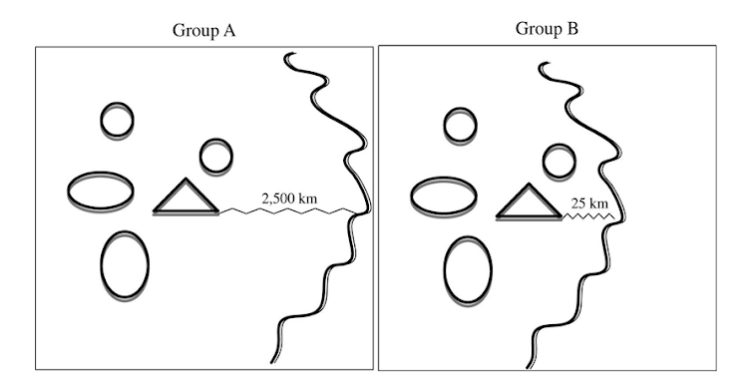
10) The diagram shows two sets of islands. Group A is located 2,500 kilometers from the nearest mainland, whereas Group B is located about 25 kilometers from the mainland. Which of the following statements is most likely accurate in comparing the number of unique species (that is, that had evolved in that place) in Island Groups A and B?
A. There will be no difference in the number of unique species in the two island groups.
B. There will be more unique species in Island Group A.
C. There will be more unique species in Island Group B
D. There is not enough information to make a prediction.
B
11) Cystic fibrosis is a genetic disorder in humans where the person has two homozygous recessive alleles for the gene. If the disease is left untreated, it causes severe health problems in the individual. If 9 in 10,000 newborn babies have the disease, what are the expected frequencies of the dominant (A1) and recessive (A2) alleles according to the Hardy-Weinberg equation?
A. f(A1) = 0.9604, f(A2) = 0.0392
B. f(A1) = 0.9700, f(A2) = 0.0300
C. f(A1) = 0.9997, f(A2) = 0.0003
D. f(A1) = 0.9800, f(A2) = 0.0200
B
12) Suppose 64% of the individuals in a remote mountain village can taste phenylthiocarbamide (PTC) and must, therefore, have at least one copy of the dominant PTC taster allele. If this population conforms to Hardy-Weinberg equilibrium for this gene, what percent of the population must be heterozygous for this trait?
A. 32%
B. 16%
C. 40%
D. 48%
D
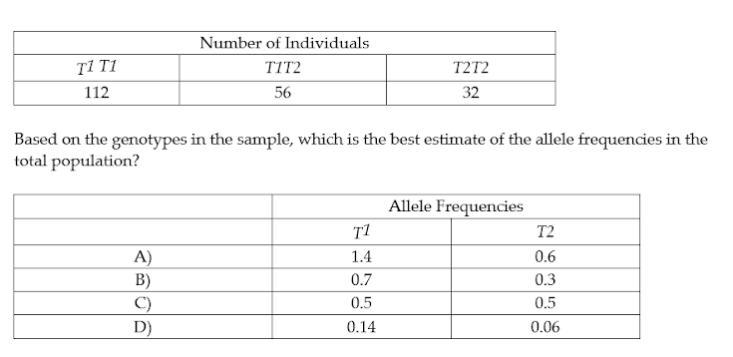
13) Researchers studying a small milkweed population note that some plants produce a toxin and other plants do not. They identify the gene responsible for toxin production. One allele (T1) codes for an enzyme that makes the toxin, and another allele (T2) codes for a nonfunctional enzyme that cannot produce the toxin. Heterozygotes produce an intermediate amount of toxin. The genotypes of a random sample of 200 individuals in the population were identified as shown in the table.
A
B
C
D
B
14) Researchers studying a small milkweed population note that some plants produce a toxin and other plants do not. They identify the gene responsible for toxin production. One allele (T1) codes for an enzyme that makes the toxin, and another allele (T2) codes for a nonfunctional enzyme that cannot produce the toxin. Heterozygotes produce an intermediate amount of toxin. The allele frequency of T1 is determined to be 0.6 and the allele frequency of T2 is 0.4. What is the expected frequency of heterozygotes if the population is in Hardy-Weinberg equilibrium?
A. 0.48
B. 0.25
C. 0.5
D. 0.65
A
15) In a Hardy-Weinberg population with two alleles A1 and A2 that are in equilibrium, the frequency of the allele A2 is 0.3. What is the frequency of individuals that are homozygous for this allele?
A. 0.49
B. 0.09
C. 0.9
D. 9.0
B
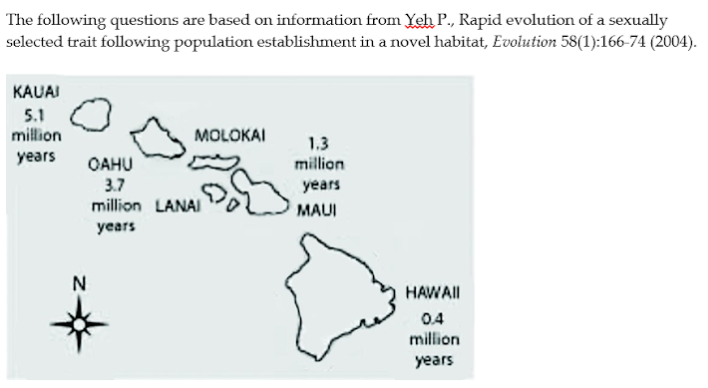
16) The Hawaiian Islands are the tops of undersea volcanoes in the Pacific Ocean. The oldest islands are the northwest-most islands. The islands get progressively younger to the southeast. Hawaii, the "big island," arose from the ocean less than one million years ago. Which of the following processes likely most strongly influenced the evolution of life on the big island when organisms first arrived?
A. the founder effect
B. the bottleneck effect
C. sexual selection
D. habitat differentiation
A
17) A population of dark-eyed junco birds became established near the California coastline, many miles from the junco's normal habitat in the mixed-coniferous temperate forests in the mountains. Juncos have white outer tail feathers that the males display during aggressive interactions and during courtship displays. Males with more white in their tail are more likely to win aggressive interactions, and females prefer to mate with males with more white in their tails. Population sizes in the coastal areas have been reasonably large, and there are significant differences between the coastal and the mountain habitats. The coastal habitat is more open (making birds more visible) and has a lower junco density (decreasing intraspecific competition) than the mountain forests. Given this information, which of the following evolutionary mechanisms is the most likely cause of the difference between the coastal and mountain populations?
A. genetic drift
B. gene flow
C. mutation
D. natural selection
D
18) Imagine a small herbaceous flowering plant whose conservation status is "endangered." Which of the following possible experiments would best test if a lack of genetic variability was partially responsible for low population numbers?
A. compare seed production rates in small versus large plants
B. compare flower production rates in plants from populations that occur in dry versus moist conditions
C. compare seed production rates in plants that are hand-pollinated with pollen from nearby individuals versus individuals 10 kilometers away
D. compare flower production rates in small versus large plants
C
19) Imagine a human population with an extremely low frequency of sickle cell alleles. Which of the following changes is most likely in the human population 15 generations after introducing a mosquito population that carries the malaria parasite?
A. a decrease in the number of mosquito bites
B. an increase in the sickle cell allele
C. an increase in red blood cells without nuclei
D. an increase in the mutation rate of the hemoglobin gene
B
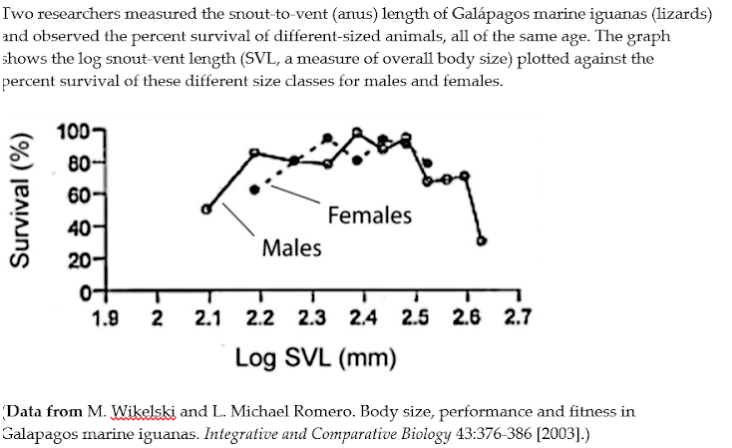
20) Two researchers measured the snout-to-vent (anus) length of Galápagos marine iguanas (lizards) and observed the percent survival of different-sized animals, all of the same age. The graph shows the log snout-vent length (SVL, a measure of overall body size) plotted against the percent survival of these different size classes for males and females. Based on the data in the figure, what type of selection for body size appears to be occurring in these marine iguanas?
A. disruptive selection
B. directional selection
C. stabilizing selection
D. You cannot determine the type of selection from the above information.
C
21) Almost all peppered moths in England were light colored before the Industrial Revolution. However, some dark forms were collected–the dark color is determined by a single, dominant allele of one gene. The bark of trees became darker during the Industrial Revolution in areas where heavy coal use in factories caused pollution. By about 1900, approximately 90% of the moths around industrial areas were dark, whereas light-colored moths were still abundant elsewhere. Apparently, birds could readily find the light moths against the dark trees in industrial areas and, therefore, were eating more light moths. Recently, use of cleaner fuels has resulted in tree bark becoming lighter again and the dark-colored moths have been disappearing. Which of the following statements best explains whether we should consider the forms different species?
A. They are different species–as shown by the fact that natural selection has affected the frequency of the two forms.
B. They are NOT different species–as shown by the fact that they can interbreed.
C. They are NOT different species–as shown by the fact that they live in the same habitats.
D. They are different species–as shown by the fact that the two forms are reproductively isolated by habitat.
B
22) Lions and tigers sometimes breed in zoos, but hybrids have not been seen in nature and even in zoos they do not reproduce well. Which of the following statements is the best conclusion that can be derived from this information?
A. The biological species concept can be applied because species are, in part, defined by the inability to produce viable, fertile offspring with other species.
B. Lions and tigers are not actually different species because they can produce viable offspring in captivity.
C. The morphological or ecological species concepts must be used rather than the biological species concept because there could be gene flow between the species in nature.
D. The biological species concept is invalid because hybrids can be formed.
A
23) Two juniper trees (Juniperus scopulorum and J. monosperma) have overlapping geographic ranges. Pollen grains (which contain sperm cells) from one species are unable to germinate and make pollen tubes on female ovules (which contain egg cells) of the other species. Which of the following isolating mechanisms keeps the two species separate?
A. behavioral isolation
B. habitat isolation
C. gametic isolation
D. temporal isolation
C
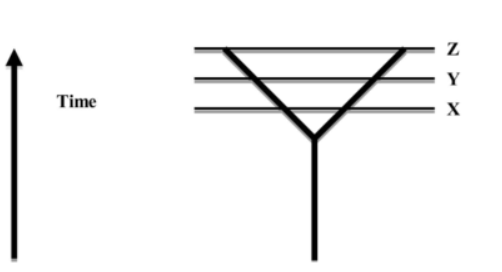
24) The diagram represents the splitting of one population into two separate lineages that become more different over time (the distance between the two lines represents the amount of difference between the two lineages). Which of the following statements about the two lineages is most accurate?
A. There are likely to be more isolating mechanisms at time X than at time Z.
B. They are more likely to fuse if they start interbreeding at time Z than at time X.
C. They are likely to be more different at time X than at time Z.
D. They are more likely to be separate species at time Z than at time X.
D
25) A team of scientists plans to study divergence of populations and needs to maximize the rate of divergence to see results within the period of their grant funding. They will form a new population by taking some individuals from a source population and isolating them so the source and new populations cannot interbreed. Which of the following strategies would maximize the likelihood of seeing divergence between the source and new populations in this study?
A. choosing individuals from one extreme of the source population to form the new population and placing the new population in the same type of an environment as the source population
B. choosing individuals from one extreme of the source population to form the new population and placing the new population in a novel environment
C. choosing individuals with the most common phenotype in the source population to form the new population and placing the new population in the same type of an environment as the source population
D. choosing individuals with the most common phenotype in the source population to form the new population and placing the new population in a novel environment as compared to that of the source population
B
26) House finches (birds) occurred only in western North America until 1939, when a few individuals were released in New York City. These individuals established a breeding population and gradually expanded their range. The western population also expanded its range somewhat eastward, and the two populations have recently come in contact. Which of the following terms best describes the process that had occurred if the two forms did not interbreed when their expanding ranges met?
A. allopatric speciation
B. reinforcement
C. sympatric speciation
D. prezygotic isolation
A
27) On the Bahamian island of Andros, mosquitofish populations live in various, now-isolated freshwater ponds that were once united. Currently, some predator-rich ponds have mosquitofish that can swim in short, fast bursts; other predator-poor ponds have mosquitofish that can swim continuously for a long time. When placed together in the same body of water, the two kinds of female mosquitofish prefer to breed only with males that have their same swimming ability. Which of the following phenomena have helped promote divergence between the mosquito populations?
A. bottlenect effect and sexual selection
B. bottlenecked effect and founder effect
C. increased gene flow and sexual selection
D. sexual selection and natural selection
D
28) Which of the following possible isolating mechanisms prevents individuals from wasting time and energy hybridizing with an individual of another species?
A. hybrid breakdown
B. behavioral isolation
C. reduced hybrid viability
D. genetic isolation
B
29) Which of the following processes would contribute to divergence between lineages once divergence has already begun?
A. sexual selection and polyploidy
B. polyploidy and hybridization
C. habitat differences and hybridization
D. sexual selection and habitat differences
D
30) A team of scientists is trying to understand the evolutionary history of three species of grasses. They hypothesize that Species T is a descendent of a hybrid between Species R and Species S. Which of the following experimental approaches would best help elucidate the evolutionary history of these three species?
A. Sequence the DNA of all three species and determine which alleles are unique to each species.
B. Hybridize Species R and S; induce tetraploidy in the hybrids; and compare the hybrids to Species T.
C. Hybridize Species R and S; plant the hybrid offspring in environmental conditions similar to those of Species R; follow the morphological and genetic changes in the offspring of the hybrids; and compare any observed changes to Species R.
D. Hybridize Species R and S; plant the hybrid offspring in environmental conditions resembling those of Species R, S, and T; follow morphological and genetic changes in the offspring of the hybrids; and compare the observed changes to Species T.
D
31) In 2013, researchers constructed a vesicle that could copy a template strand of RNA. Which of the following best states the significance of this evidence with regard to the abiotic origin of life?
A. This experimental achievement proved that such vesicles could produce daughter protocells.
B. This experimental achievement demonstrated that RNA is a more chemically stable repository of information than is DNA.
C. On early Earth, such vesicles could increase in abundance more than vesicles that could not copy a template strand of RNA.
D. On early Earth, such vesicles were better able to acquire energy than vesicles that could not copy a template strand of RNA.
C
32) Which of the following pieces of evidence provides the best support for the claim that natural selection affected the evolution of ribozymes?
A. Single-stranded RNA can have many shapes.
B. Some strands of RNA replicate more often than others.
C. Some strands of RNA are extremely chemically stable.
D. Replication of RNA is flawless.
B
33) Which of the following results, if found on ancient meteorites, would suggest that meteorites were NOT the source of amino acids that contributed to the origin of life on Earth?
A. the presence of up to 80 different amino acids
B. the presence of other organic molecules (e.g., lipids, sugars, and nitrogenous bases) in addition to amino acids
C. the absence of amino acids
D. the presence of only D-isomers of amino acids
D
34) Which of the following methods is the most accurate way to measure the age of a relatively recent fossil?
A. ratio of uranium-238 to thorium-234
B. sequences of fossils in rock strata
C. ratio of carbon-14 to carbon-12
D. ratio of plutonium-244 to uranium 240
C
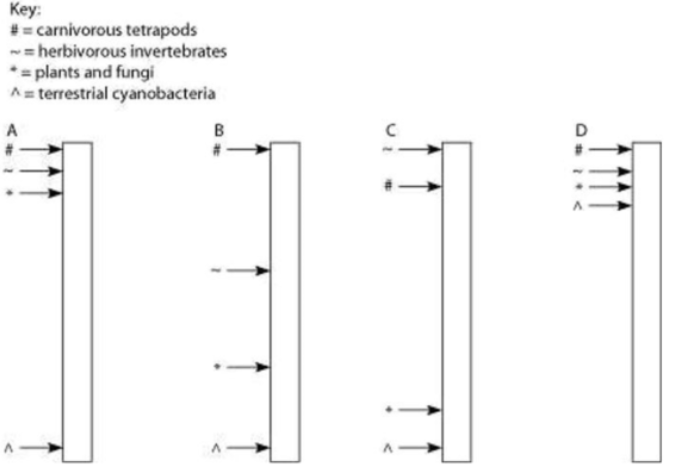
35) Four sediment cores were removed from the floor of an inland sea. The sea was in existence intermittently throughout the entire time that terrestrial life has existed. Researchers wish to locate and study the terrestrial organisms fossilized in these cores. In the diagram, the cores are illustrated as vertical columns, with the top of the column representing the most recent strata and the bottom representing the time when land was first colonized by life. Which of the following factors would best allow a researcher to assign absolute dates to the fossils in the sediments?
A. equal spacing of fossils throughout the columns
B. presence of volcanic ash layers between the sedimentary strata
C. knowledge that the sediments had not been affected by underwater currents during their deposition
D. knowledge of the order in which the fossils were deposited
B
36) The temporal fenestra in the skulls in fossils of ancestral mammals changed in shape and size over time. These changes were most likely due to changes in the muscles that closed the jaws. Which of the following research approaches would be most helpful for understanding the evolutionary benefits of these changes?
A. comparing the changes in the fenestra in the fossils leading to mammals with the changes in the fossils leading to modern reptiles
B. correlating the strength of jaw closure and the size and hardness of potential prey
C. comparing changes in the fenestra with changes in the jaw hinge
D. correlating the fenestra size with changes in the shape of the teeth
B

37) Four sediment cores were removed from the floor of an inland sea. The sea was in existence intermittently throughout the entire time that terrestrial life has existed. Researchers wish to locate and study the terrestrial organisms fossilized in these cores. In the diagram, the cores are illustrated as vertical columns, with the top of the column representing the most recent strata and the bottom representing the time when land was first colonized by life. If the arrows indicate locations in the column where fossils of a particular type (see key) first appear, then which sediment core provides the best support for the current model of the evolution of terrestrial organisms?
A. core A
B. core B
C. core C
D. core D
A
38) Mycorrhizae are symbiotic associations between some fungi and the roots of many plants. Which of the following experiments best would test whether a plant benefits from the presence of the fungus?
A. Grow many individuals of Plant X in shaded and unshaded conditions. Then compare the average plant size and average number of seeds produced between the two groups.
B. Grow many individuals of Plant X with two different species of fungi. Then compare the average plant size and average number of seeds produced between the two groups.
C. Grow many individuals of Plant X and Plant Y without any fungus. Then compare the average plant size and average number of seeds produced between the two groups.
D. Grow many individuals of Plant X with and without its fungus. Then compare the average plant size and average number of seeds produced between the two groups.
D
39) Which of the following factors most likely prevented adaptive radiation by mammals before the dinosaurs went extinct?
A. variation in teeth of the original mammals
B. nocturnal vision of the original mammals
C. predation of dinosaur eggs by the original mammals
D. competition for food with the dinosaurs
D
40) Several dozen different proteins comprise the prokaryotic flagellum and its attachment to the prokaryotic cell, producing a highly complex structure. Certain proteins of the complex motor that drives bacterial flagella are modified versions of proteins that had previously belonged to plasma membrane pumps. This evidence best supports which of the following claims?
A. Natural selection produces organs that will be needed in future environments.
B. The motors of bacterial flagella must have originated in other organisms.
C. Bacteria that possess flagella must have lost the ability to pump certain chemicals across their plasma membranes.
D. Natural selection can favor new structures that have been coupled together from parts of other structures.
D
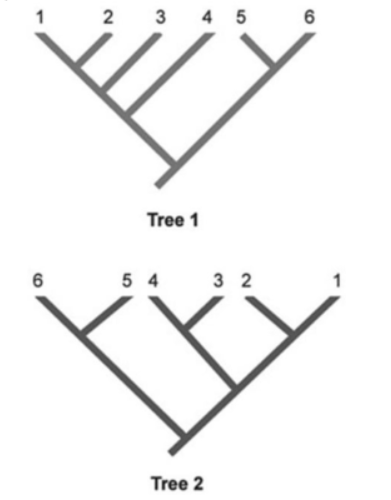
41) In the phylogenetic trees shown, each number represents a unique species of organisms. Which two species are represented as sister species in Tree 2 but are not represented as sister species in Tree 1?
A. 3 & 4
B. 1 & 2
C. 2 & 3
D. 4 & 5
A
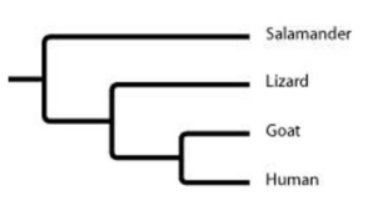
42) Which of the following statements is most consistent with the model of evolutionary relatedness represented in the phylogenetic tree?
A. Goats and humans are the only sister group in this tree.
B. Salamanders are more closely related to lizards than they are to humans.
C. Goats are more closely related to salamanders than they are to humans.
D. Salamanders are a sister group to the group containing lizards, goats, and humans.
D
43) Which of the following pairs is the best example of homologous structures?
A. the shape of the dorsal fin in dolphins and the shape of the dorsal fin in sharks
B. eyelessness in the Australian mole and eyelessness in the North American mole
C. bones in the bat wing and bones in the human forelimb
D. wings on an owl and wings on a hornet
C
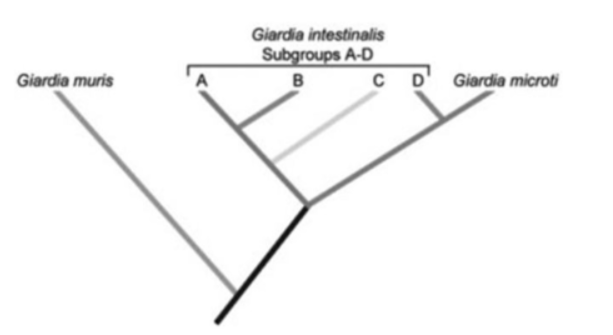
44) According to the phylogenetic tree in the figure above, what type of evolutionary group does G. intestinalis constitute?
A. paraphyletic
B. monophyletic
C. analogous
D. polyphyletic
A

45) In the table, a Y indicates that the listed species possess trait 1, 2, or 3 and an N indicates that the listed species do not possess the trait. Given that phylogenies are based on shared derived characteristics, which of the following traits is useful in generating a phylogeny of species A, B, C, and D?
A. Trait 1
B. Trait 2
C. Trait 3
D. Traits 1, 2, & 3
B

46) The question refers to the table, which compares the percent sequence homology of four different parts of a gene (two introns and two exons) that is found in five different eukaryotic species. The data show the percentage of sequence homology of each intron and exon in comparison to the sequences in species A. Regarding these sequence homology data, how would the principle of maximum parsimony be applicable in comparing them?
A. inferring evolutionary relatedness from the number of sequence differences
B. distinguishing introns from exons
C. selecting appropriate genes for comparison among species
D. determining degree of sequence homology
A
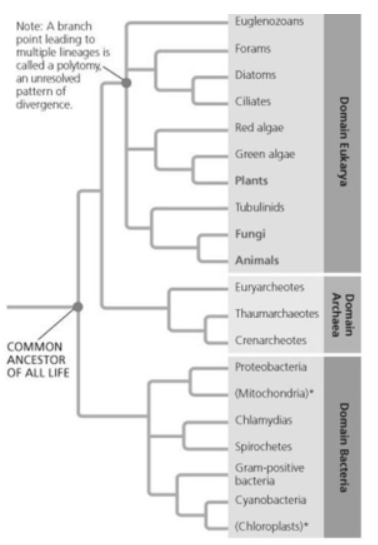
47) Cyanobacteria were once called blue-green algae because they are photosynthetic. According to the phylogeny shown, to which of the following organisms are the cyanobacteria more closely related?
A. gram-positive bacteria
B. euglenozoans
C. green algae
D. crenarcheotes
A
48) If you were using cladistics to build a phylogenetic tree of cats, which of the following organisms would be the best outgroup?
A. lion
B. leopard
C. domestic cat
D. wolf
D
49) Which of the following information would be most useful in creating a phylogenetic tree of a taxon?
A. a knowledge of mutation rates in modern species
B. morphological data from fossil and living species
C. a knowledge of color patterns in fossil and living species
D. morphological data from fossil species
B
50) Your professor wants you to construct a phylogenetic tree of a type of plant called orchids. She gives you tissue from seven orchid species and one lily plant. What is the most likely reason she gave you the lily?
A. to serve as an outgroup
B. to see if the lily is an ancient orchid species
C. to demonstrate likely genetic similarities
D. to see if the lily and the orchids show all the same shared derived characters
A
51) A bacterium has the following characteristics:∙ It adheres to the human intestinal lining using a feature that protects it from phagocytes, bacteriophages, and dehydration.∙ It can survive being boiled.∙ It contains no plasmids and relatively little peptidoglycan. Which of the following characteristics allows this bacterium to survive in a human who is taking penicillin pills?
A. gram-negative cell wall
B. lipopolysaccharides in the cytoplasm
C. peptidoglycan in the cell wall
D. long polypeptides in the cell wall
A
52) A bacterium has the following characteristics:∙ It adheres to the human intestinal lining using a feature that protects it from phagocytes, bacteriophages, and dehydration∙ It can survive being boiled∙ It contains no plasmids and relatively little peptidoglycan. Which of the following characteristics allows this bacterium to adhere to the intestinal lining?
A. pili
B. fimbriae
C. a flagelluman
D. endospore
B
53) Some bacteria possess antibiotic resistance, as well as the ability to survive through adverse conditions. Where in this type of bacteria is the DNA located?
A. fimbriae, nucleoid, and endospore
B. plasmids, nucleoid, and endospore
C. endospore, fimbriae, and plasmids
D. nucleoid, fimbriae, and plasmids
B
54) Which of the following statements is the most likely result of conjugation involving a bacterium that contains a copy of a plasmid containing a gene for tetracycline resistance with one that does not?
A. the subsequent loss of tetracycline resistance from this bacterium
B. the temporary possession by this bacterium of a completely diploid genome
C. the production of endospores among the bacterium's progeny
D. the rapid spread of tetracycline resistance to other bacteria in the population
D
55) While examining a rock surface, you have discovered an interesting new organism. Which of the following criteria will allow you to classify the organism as belonging to Bacteria but not Archaea or Eukarya?
A. It can survive at a temperature over 100°C.
B. The organism does not have a nucleus.
C. Cell walls are made primarily of peptidoglycan.
D. The lipids in its plasma membrane consist of glycerol bonded to straight-chain fatty acids.
C
56) Assuming that each of these prokaryotes possesses a cell wall, which ones are expected to be most strongly resistant to significant water loss in hypertonic environments?
A. cyanobacteria
B. extreme thermophiles
C. methanogens
D. extreme halophiles
D
57) A fish that has been salt-cured subsequently develops a reddish color. You suspect that the fish has been contaminated by the extreme halophile Halobacterium. Which of these features of cells removed from the surface of the fish would support your suspicion?
A. the presence of the same photosynthetic pigments found in cyanobacteria and cell walls that lack peptidoglycan
B. cells unable to survive salt concentrations lower than 9% and cells containing many ion pumps on the plasma membrane
C. the presence of the same photosynthetic pigments found in cyanobacteria and cells that are isotonic to conditions on the surface of the fish
D. cell walls that lack peptidoglycan and are isotonic to conditions on the surface of the fish
D
58) Which of the following statements correctly describes a process by which bacteria become resistant to antibiotics?
A. antibiotics cause mutation in bacteria, making them resistant
B. conjugation spreads antibiotic resistance genes rapidly in a population
C. bacteria reproduce slowly, allowing mutation to become widespread in a population
D. some bacteria produce exotoxins that breakdown antibiotics, rendering them nonfunctional.
B
59) The CRISPR-Cas system helps some prokaryotes defend against infection by viruses. Which of the following statements correctly describes how this system works?
A. it produces RNA that is translated into proteins that attack viral DNA
B. it causes proteins to synthesize proteins that are then secreted by the prokaryote and attack viruses
C. it cuts DNA at specific sequences to which it is directed
D. it inserts specific genes into the prokaryotic genome
C
60) Use of synthetic fertilizers often leads to the contamination of groundwater with nitrates. Nitrate pollution is also a suspected cause of anoxic "dead zones" in the ocean. Which of the following processes is most likely to help reduce nitrate pollution?
A. adding nitrifying bacteria to the soil
B. using ammonia instead of nitrate as a fertilizer
C. adding methanogens to the soil
D. adding denitrifying bacteria to the soil
D